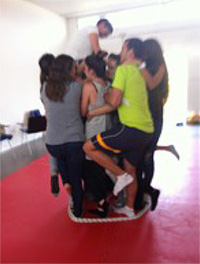 Introduction
Introduction
Group dynamics is a system of behaviours and psychological processes occurring within a social group (intragroup dynamics), or between social groups (intergroup dynamics).
Team Building activities & Group Dynamics theory of process combine to improve the effectiveness of teams to generate desired outputs and outcomes.
An influential Theory of Group Dynamics was published by Dr Bruce Tuckman in 1965. His model consisted of 4 stages: Forming Storming Norming Performing. He added a fifth stage, Adjourning, in the 1970s. The Forming Storming Norming Performing theory is an elegant and helpful explanation of team development and behaviour. Similarities can be seen with other models, such as Tannenbaum and Schmidt Continuum and especially with Hersey and Blanchard’s Situational Leadership® model, developed about the same time.
Tuckman’s model explains that as the team develops maturity and ability, relationships establish, and the leader changes leadership style. Beginning with a directing style, moving through coaching, then participating and ending in delegating and almost detached. At this point the team may produce a successor leader and the previous leader can move on to develop a new team.
Forming – stage 1
High dependence on the leader for guidance and direction. Little agreement on team aims other than those received from leader. Individual roles and responsibilities are unclear. Leader must be prepared to answer lots of questions about the team’s purpose, objectives and external relationships. Processes are often ignored. Members test tolerance of system and leader. Leader directs.
Storming – stage 2
Decisions don’t come easily within the group. Team members vie for position as they attempt to establish themselves in relation to other team members and the leader, who might receive challenges from some team members. Clarity of purpose increases but plenty of uncertainties persist. Cliques and factions form and there may be power struggles. The team needs to be focused on its goals to avoid becoming distracted by relationships and emotional issues. Compromises may be required to enable progress.
Norming – stage 3
Agreement and consensus largely forms among the team, who respond well to facilitation by leader. Roles and responsibilities are clear and accepted. Big decisions are made by group agreement. Smaller decisions may be delegated to individuals or small teams within group. Commitment and unity is strong. The team may engage in fun and social activities. The team discusses and develops its processes and working style. There is general respect for the leader and some of leadership is more shared by the team. Leader facilitates and enables (similar to the Situational Leadership® ‘Participating’ mode).
Performing – stage 4
The team is more strategically aware; the team knows clearly why it is doing what it is doing. The team has a shared vision and is able to stand on its own feet with no interference or participation from the leader. There is a focus on over-achieving goals, and the team makes most of the decisions against criteria agreed with the leader. The team has a high degree of autonomy. Disagreements occur but now they are resolved within the team positively, and necessary changes to processes and structure are made by the team. The team is able to work towards achieving the goal, and also to attend to relationship, style and process issues along the way. Team members look after each other. The team requires delegated tasks and projects from the leader. The team does not need to be instructed or assisted. Team members might ask for assistance from the leader with personal and interpersonal development. Leader delegates and oversees.
A similar, but also useful model, was suggested by Gerald Corey (before a group could progress to a deeper level to work together), they should experience a transitional phase:
(Pre-group Issues: Formation of Group)
- Initial Stage: Orientation & Exploration
- Transition Stage: Dealing with Resistance
- Working Stage: Cohesion and Productivity
- Final Stage: Consolidation and Termination
(Post-group Issues – Evaluation & Follow Up.)
Initial Stage- Orientation and exploration: In this stage the cohesion of the group is required to move from initial to transition, within an environment of trust, established with explicit and implicit norms. “For a group to meet the working stage it is essential that members make a commitment to face and work through barriers that interfere with the group’s progress.”
- Central task- establishing trust
- Leader- establishes structure and models trust
- Members- develop trust by how leader handles the group’s fears and hesitations
- Initial resistance- listen to fears and encourage full expression of them.
Transition Stage-Cohesion: This stage is about recognising group problems such as conflict, anxiety, defensiveness, challenges to or conflicts with the leader.
- Central Task- Cohesion.
- Leader-Continually encourage members to say aloud what they are thinking and be aware about what is happening within the group.
- Members-To establish trust, the group must experience two levels of trust
- High trust characteristics: Participate, engage, take risks, disclose feelings, focus on them, support and challenge others.
- Low trust characteristics: Disengaged, untimely (show up late/leave early/ miss/session), hesitant to express themselves, quiet; focus on others, demanding of group leader, avoidant, form cliques.
In this stage the reluctant behaviour and the defensiveness is a normal way of interaction. Members in the group are trying to protect themselves from anxiety and from the risk to trust in the other members of the group. Members are proceeding with caution.
Working Stage: Is characterised by the commitment of members to explore significant tasks.
- Central task-Group evolution, less intervention is required than in the two initial stages.
- Leader-Leads the activities focusing on the task more than on the mediation (just in case of conflict).
- Members-They are not becoming co-leaders, but they do initiate work more readily. Not all the members are working on the same level because they cannot do the same roles.
Key Issues:
- Disclosure versus anonymity
- Honesty versus superficiality
- Spontaneity versus control
Acceptance versus Rejection - Cohesion versus Fragmentation
Characterised by member’s commitment to explore significant problems that they bring to the group and by the attention they pay to the dynamics of the group. The leader’s structure and intervention is lower than at the initial and transitional stages.
Greater cohesion evidenced by increased self-disclosure, giving and receiving feedback, discussion of here and now interactions, confrontation, turning insight into action. It is essential that members make a commitment to face and work through barriers that could interfere with the group progress.
Not all the groups reach a working stage, if they don’t develop enough trust between them, they can get stuck in the transition stage.
Final Stage:
Characteristics- sadness and anxiety, fears of separation and application, evaluation of group experience, plan for follow-up progress.
Leader functions- provide a structure that enables participants to clarify the meaning of their experiences in the group and to assist members in generalising their learning from the group to everyday life.
Main task members have to face when the group will be separated, is consolidating their learning and transferring it to the outside environment:
- deal with feelings about separation and termination
- prepare to generalise learning to everyday life
- complete unfinished business
- make future plans
 Activity
Activity

Objective: This activity is a team game that can help you to add new members to the group to develop problem solving and communication skills.
Contents: You have to build and improvise a “boat” on the floor with some pieces of wood, carpet or any other resource you may have, for example: foam tiles.
Once all the pieces are on the floor, the team has to try to place at least one of their feet on the “boat”. When all the members are in the boat, the leader of the activity starts to take away pieces from the boat. After each time the leader takes out a piece, the team has to readjust themselves. Any time that one of the members steps out of the boat, will be the end of the game.
The aim is to keep the boat with the largest number of members inside, until the leader decides that is has finished. The end of the game will be once the boat is without members, or with a specific number of members (3, 4,).
At the end of the activity, members of the group will discuss with the leader how they were feeling during the process, if they felt supported or not by them.
It is important to listen to all the voices and the roles.
Material: Wood, carpets, pieces of paper, strings or any material to build the “boat”.
 Case studies
Case studies
The Director wanted effective communication between staff members, to demonstrate that students’ emotional safety is critical for their learning, as well as the development of positive staff and student relationships which is crucial to create a culture of mutual trust and respect.
In order to engage all the staff working in the school, the Director involved them in group dynamics, thus building trust between them. This occurred in small and weekly groups.
The Director noticed a change from the first year with the new approach implemented over three years. Once members of staff felt comfortable laying their issues on the table where they could be discussed, they were able to construct a common vision of schooling. Students were benefitting from a more positive environment, helping everybody to row in the same direction.
This approach has been used extensively by practitioners and with great success, as the experience of the process reinforces the theory and completes an effective learning journey.
Reflecting Questions:
- What was the basic problem faced by the school at the beginning?
- How did the school face the problem?
- Could you detect the differences as a result of the group dynamics?
- Do you think that this is an issue in your school?
- Do you have the tools to work in the same way in your school?
- Could you organise team building sessions?
- Do you think that this could change the relationships among your colleagues?
